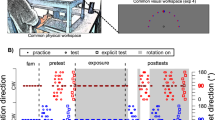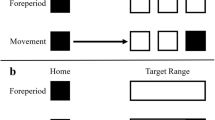Abstract
In the present study, we examined how subjects locate spatial positions and code them in short-term memory. In the first experiment, blindfolded subjects were asked to perform movements in the near or far peripersonal space (criterion movement, CM). Then, subjects had to reach the end-point of CM (reproduction movement, RM). Movements could be performed either slowly or rapidly. Also, CM and RM could be performed with the same (congruent conditions) or different velocity (incongruent conditions). The results showed that performance was accurate in the two congruent conditions. Conversely, in the incongruent conditions, subjects made undershoot errors when the CM was fast and overshoot errors when it was slow. In the second experiment, blindfolded subjects also performed CM and RM in congruent or incongruent conditions. However, the CM and RM could start from the same or different position. We found again undershoot errors when the CM was fast and RM was slow and overshoot errors in the reverse condition. The results of both experiments suggest that the information about movement velocity contributes to the kinaesthetic coding in memory of a spatial location to be reached with arm movement.


Similar content being viewed by others
References
Chieffi S, Allport DA (1997) Independent coding of target distance and direction in visuo-spatial working memory. Psychological Res 60:244–50
Chieffi S, Allport DA, Woodin M (1999) Hand-centred coding of target location in visuo-spatial working memory. Neuropsychologia 37:495–502
Craggo PE, Houk J, Hasan Z (1976) Regulatory actions of human stretch reflex. J Neurophysiol 39:925–935
Ferrell WR, Gandevia SC, McCloskey DI (1987) The role of joint receptors in human kinaesthesis when intramuscolar receptor cannot contribute. J Physiol 386:63–71
Hore J, Preston JP, Durkovic RG, Cheney PD (1976) Responses of cortical neurons (areas 3a and 4) to ramp stretch of hindlimb muscles in the baboon. J Neurophysiol 38:1436–1477
Hollins M, Goble AK (1988) Perception of length of voluntary movements. Somatosens Res 5:335–348
Jones B (1972) Outflow and inflow in movement duplication. Percept Psychophysics 12:95–96
Kerr B (1978) The effect of invalid task parameters on short-term motor memory. J Motor Behav 10:261–273
Lee RG, Tatton W (1975) Motor responses to sudden limb displacements in primates with specific CNS lesions and in human patients with motor system disorders. Canad J Neurol Sci 2:285–293
Marteniuk RG, Roy EA (1972) The codability of kinesthetic location and distance information. Acta Psychol 36:471–479
McCloskey DI (1973) Differences between the sense of movement and position shown by the effects of loading and vibration of muscles in man. Brain Res 61:119–131
McCloskey DI (1978) Kinesthetic sensibility. Physiol Rev 58:763–820
Poulton EC (1981) Human manual control. In: VB Brooks (ed) Handbook of phisiology: the nervous system, vol. 2. American Physiological Society, Bethesda, MD, pp 339–1389
Rizzolatti G, Fadiga L, Fogassi L, Gallese V (1997) The space around us. Science 277:190–191
Rosenbaum DA, Meulenbroek RJ, Vaughan J (1999) Remembered positions: stored locations or stored postures? Exp Brain Res 124:503–512
Sittig AC, Denier van der Gon JJ, Gielen CCAM (1985) Separate control of arm position and velocity demonstrated by vibration of muscle tendon in man. Exp Brain Res 60:445–453
Sittig AC, Denier van der Gon JJ, Gielen CCAM (1987) The contribution of afferent information on position and velocity to the control of slow and fast human forearm movements. Exp Brain Res 67:33–40
Smeets JB, Erkelens C, van der Gon J (1990) Adjustments of fast goal-directed movements in response to an unexpected inertial load. Exp Brain Res 81:302–312
Soechting JF, Flanders M (1989a) Sensorimotor representations for pointing to targets in three-dimensional space. J Neurophysiol 62:582–594
Soechting JF, Flanders M (1989b) Errors in pointing are due to approximations in sensorimotor transformation. J Neurophysiol 62:595–608
Wapner SJ, Weinberg J, Glick JA, Rand G (1967) Effect of speed of movement on tactual-kinesthetic perception of extent. Amer J Psychol 80:608–613
Acknowledgements
The authors thank the anonymous reviewers for helpful comments on an early version of the paper.
Author information
Authors and Affiliations
Corresponding author
Rights and permissions
About this article
Cite this article
Chieffi, S., Conson, M. & Carlomagno, S. Movement velocity effects on kinaesthetic localisation of spatial positions. Exp Brain Res 158, 421–426 (2004). https://doi.org/10.1007/s00221-004-1916-z
Received:
Accepted:
Published:
Issue Date:
DOI: https://doi.org/10.1007/s00221-004-1916-z




